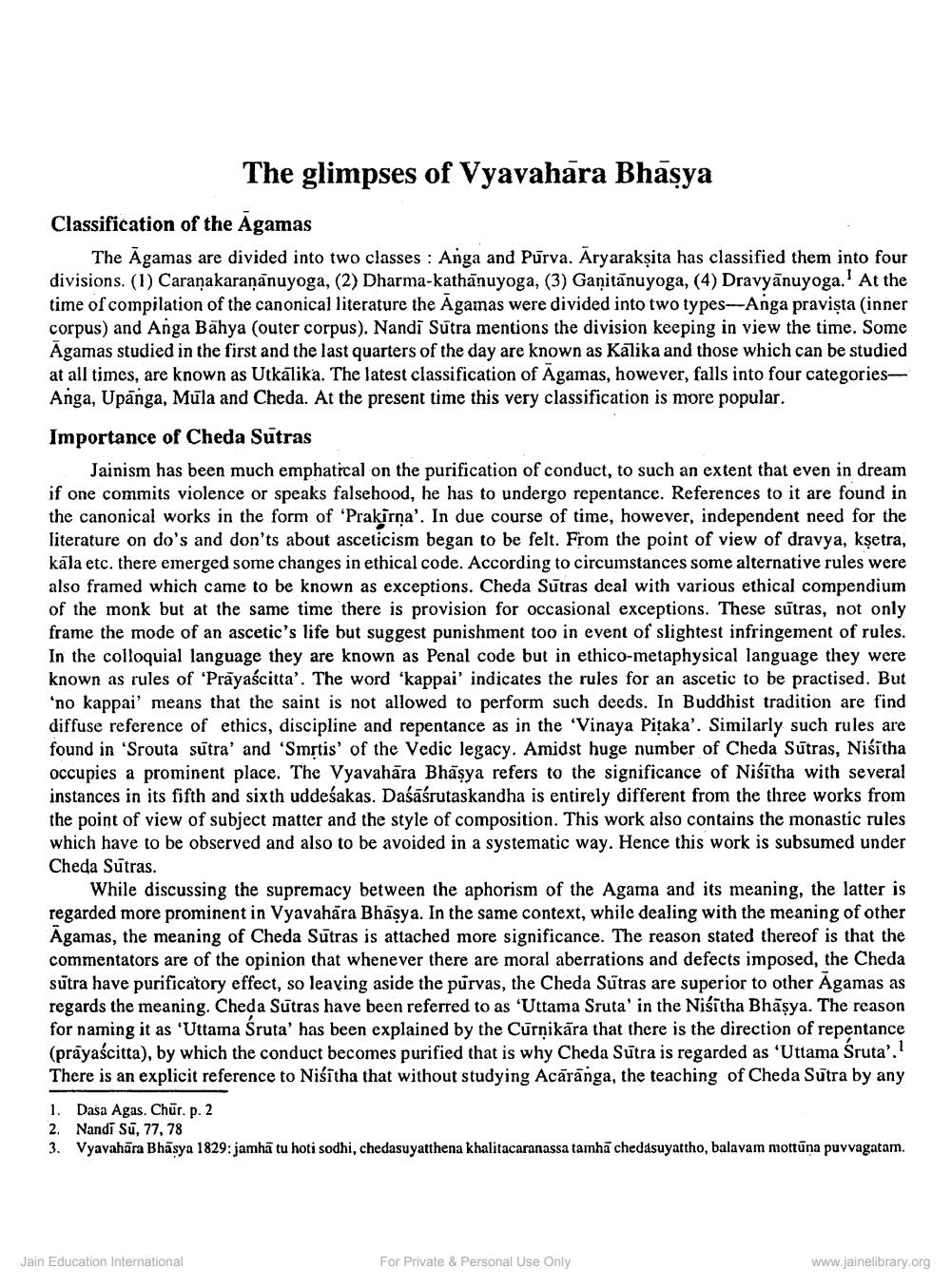________________
The glimpses of Vyavahara Bhasya
Classification of the Agamas
The Agamas are divided into two classes: Anga and Purva. Aryarakṣita has classified them into four divisions. (1) Caranakaraṇānuyoga, (2) Dharma-kathanuyoga, (3) Ganitanuyoga, (4) Dravyanuyoga.1 At the time of compilation of the canonical literature the Agamas were divided into two types-Anga pravista (inner corpus) and Anga Bähya (outer corpus). Nandi Sutra mentions the division keeping in view the time. Some Āgamas studied in the first and the last quarters of the day are known as Kalika and those which can be studied at all times, are known as Utkalika. The latest classification of Agamas, however, falls into four categoriesAnga, Upanga, Mula and Cheda. At the present time this very classification is more popular.
Importance of Cheda Sutras
Jainism has been much emphatical on the purification of conduct, to such an extent that even in dream if one commits violence or speaks falsehood, he has to undergo repentance. References to it are found in the canonical works in the form of 'Prakira'. In due course of time, however, independent need for the literature on do's and don'ts about asceticism began to be felt. From the point of view of dravya, kṣetra, kala etc. there emerged some changes in ethical code. According to circumstances some alternative rules were also framed which came to be known as exceptions. Cheda Sutras deal with various ethical compendium of the monk but at the same time there is provision for occasional exceptions. These sutras, not only frame the mode of an ascetic's life but suggest punishment too in event of slightest infringement of rules. In the colloquial language they are known as Penal code but in ethico-metaphysical language they were known as rules of 'Prayaścitta'. The word 'kappai' indicates the rules for an ascetic to be practised. But 'no kappai' means that the saint is not allowed to perform such deeds. In Buddhist tradition are find diffuse reference of ethics, discipline and repentance as in the 'Vinaya Pitaka'. Similarly such rules are found in 'Srouta sutra' and 'Smṛtis' of the Vedic legacy. Amidst huge number of Cheda Sutras, Niśitha occupies a prominent place. The Vyavahara Bhasya refers to the significance of Niśitha with several instances in its fifth and sixth uddeśakas. Daśāśrutaskandha is entirely different from the three works from the point of view of subject matter and the style of composition. This work also contains the monastic rules which have to be observed and also to be avoided in a systematic way. Hence this work is subsumed under Cheda Sutras.
While discussing the supremacy between the aphorism of the Agama and its meaning, the latter is regarded more prominent in Vyavahara Bhasya. In the same context, while dealing with the meaning of other Agamas, the meaning of Cheda Sutras is attached more significance. The reason stated thereof is that the commentators are of the opinion that whenever there are moral aberrations and defects imposed, the Cheda sutra have purificatory effect, so leaving aside the purvas, the Cheda Sutras are superior to other Agamas as regards the meaning. Cheda Sutras have been referred to as 'Uttama Sruta' in the Niśitha Bhasya. The reason for naming it as 'Uttama Śruta' has been explained by the Curnikära that there is the direction of repentance (prayaścitta), by which the conduct becomes purified that is why Cheda Sutra is regarded as 'Uttama Śruta',' There is an explicit reference to Nikitha that without studying Acaranga, the teaching of Cheda Sutra by any
1. Dasa Agas. Chur. p. 2
2. Nandi Su, 77, 78
3. Vyavahāra Bhāṣya 1829: jamhā tu hoti sodhi, chedasuyatthena khalitacaranassa tamhã chedasuyattho, balavam mottuna puvvagatam.
Jain Education International
For Private & Personal Use Only
www.jainelibrary.org




